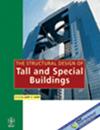Numerical study on split base plate connection with concentric anchors between steel‐plate composite wall and concrete basemat
IF 1.3
3区 工程技术
Q3 CONSTRUCTION & BUILDING TECHNOLOGY
引用次数: 3
Abstract
Steel‐plate composite (SC) walls can be connected to a concrete basemat using a base plate and a set of anchors eccentric to the wall. The base plate can be separated into two parts so that the concrete of the wall and basemat is cohesive, and thus, the wall can be manufactured more easily and economically. Additionally, compression and shear demand are directly transferred from infill concrete to concrete basemat. Another change in the base plate connection of available tested walls involves transferring anchors to the bottom of faceplates. As a result of this modification, the base plate is removed from the force transmission chain, and the force is transferred directly from the wall to the anchors. After presenting the design criteria for this type of connection, three test walls with concrete foundations were verified in LS‐Dyna. The walls were modeled with a split base plate connection and concentric anchors, and then compared to other types of wall‐basemat connections. Three rectangular sections were then chosen as benchmarks and modeled with three anchors of different sizes to evaluate the effect of this parameter on walls behavior. The design equations presented for the single base plate connection were found applicable to design split base plate connections. Then all walls were compared to the test wall‐fixed base wall connection. Finally, the models were analyzed with elastic walls to determine whether the foundation is stronger than the wall. The split base plate connection with concentric anchors was found to be stronger than connected parts and can be an alternative to existing connections.钢板组合墙与混凝土基础同心锚对开底板连接的数值研究
钢板复合(SC)墙可以使用底板和一组与墙偏心的锚固件连接到混凝土基底。底板可以分为两部分,使得墙壁和基底的混凝土具有粘性,因此可以更容易和经济地制造墙壁。此外,压缩和剪切需求直接从填充混凝土转移到混凝土基底。可用测试墙的底板连接的另一个变化涉及将锚转移到面板底部。由于这种修改,基板从力传递链上移除,并且力直接从墙传递到锚。在介绍了这种类型连接的设计标准后,在LS‐Dyna中验证了三个带混凝土基础的试验墙。墙采用分体式底板连接和同心锚进行建模,然后与其他类型的墙-基底连接进行比较。然后选择三个矩形截面作为基准,并用三个不同尺寸的锚进行建模,以评估该参数对墙性能的影响。提出的单基板连接的设计方程适用于设计分体式基板连接。然后将所有墙壁与试验墙壁固定基础墙壁连接进行比较。最后,用弹性墙对模型进行分析,以确定基础是否比墙更坚固。发现带有同心锚的分体式底板连接比连接部件更坚固,可以替代现有连接。
本文章由计算机程序翻译,如有差异,请以英文原文为准。
求助全文
约1分钟内获得全文
求助全文
来源期刊
CiteScore
5.30
自引率
4.20%
发文量
83
审稿时长
6-12 weeks
期刊介绍:
The Structural Design of Tall and Special Buildings provides structural engineers and contractors with a detailed written presentation of innovative structural engineering and construction practices for tall and special buildings. It also presents applied research on new materials or analysis methods that can directly benefit structural engineers involved in the design of tall and special buildings. The editor''s policy is to maintain a reasonable balance between papers from design engineers and from research workers so that the Journal will be useful to both groups. The problems in this field and their solutions are international in character and require a knowledge of several traditional disciplines and the Journal will reflect this.
The main subject of the Journal is the structural design and construction of tall and special buildings. The basic definition of a tall building, in the context of the Journal audience, is a structure that is equal to or greater than 50 meters (165 feet) in height, or 14 stories or greater. A special building is one with unique architectural or structural characteristics.
However, manuscripts dealing with chimneys, water towers, silos, cooling towers, and pools will generally not be considered for review. The journal will present papers on new innovative structural systems, materials and methods of analysis.

 求助内容:
求助内容: 应助结果提醒方式:
应助结果提醒方式:


